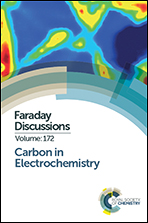Glutamate biosensors based on diamond and graphene platforms
Abstract
L-Glutamate is one of the most important neurotransmitters in the mammalian central nervous system, playing a vital role in many physiological processes and implicated in several neurological disorders, for which monitoring of dynamic levels of extracellular glutamate in the living brain tissues may contribute to medical understanding and treatments. Electrochemical sensing of glutamate has been developed recently mainly using platinum, carbon fibre and carbon nanotube electrodes. In the present work, we explore the fabrication and properties of electrochemical glutamate sensors fabricated on doped chemical vapour deposition diamond electrodes and graphene nanoplatelet structures. The sensors incorporate platinum nanoparticles to catalyse the electrooxidation of hydrogen peroxide, glutamate oxidase to oxidise glutamate, and a layer of poly-phenylenediamine to impart selectivity. The performance of the devices was compared to a similar sensor fabricated on glassy carbon. Both the diamond and the graphene sensor showed very competitive performance compared to the majority of existing electrochemical sensors. The graphene based sensor showed the best performance of the three investigated in terms of sensitivity, linear dynamic range and long term stability, whereas it was found that the diamond device showed the best limit of detection.
- This article is part of the themed collection: Carbon in Electrochemistry

 Please wait while we load your content...
Please wait while we load your content...